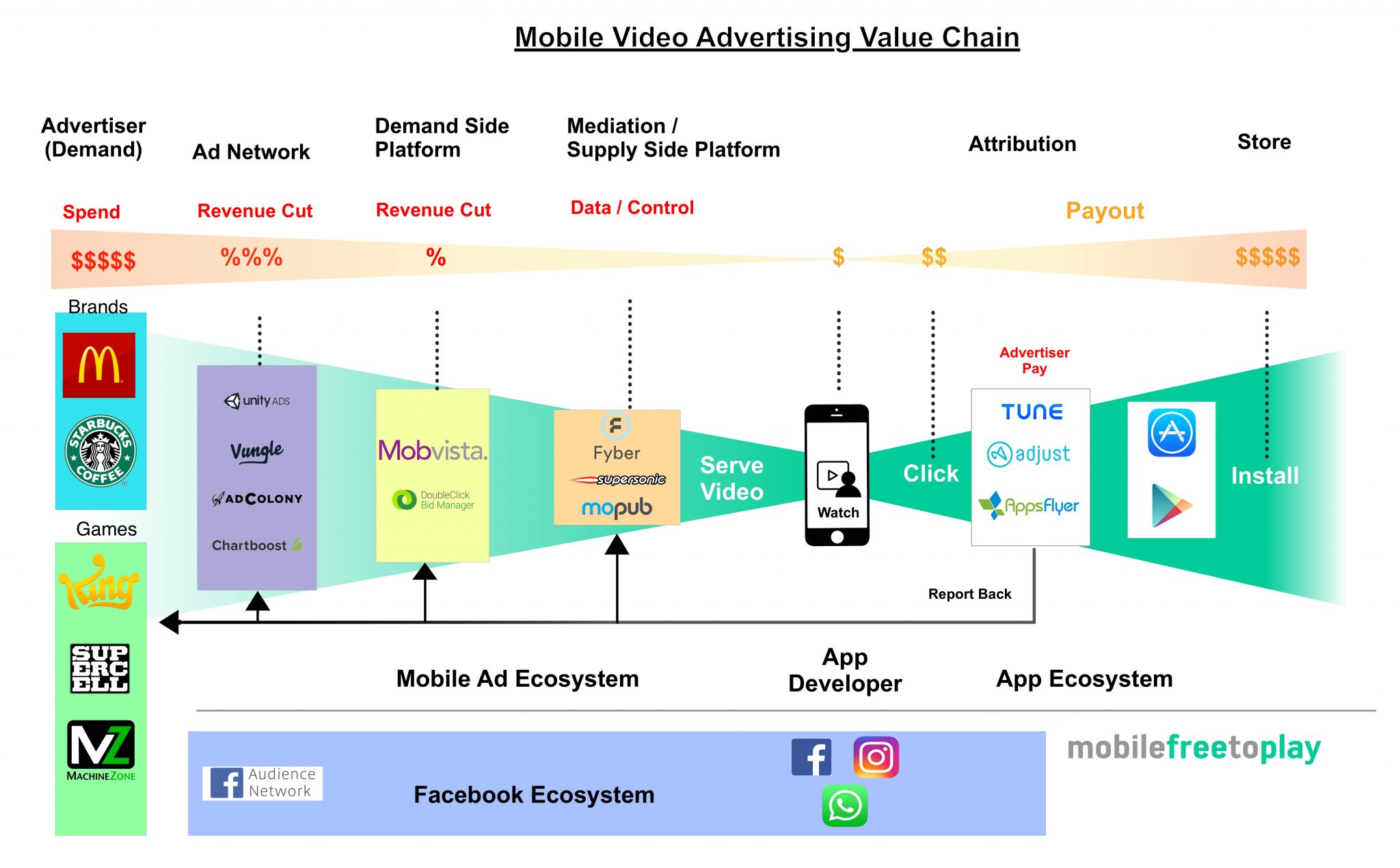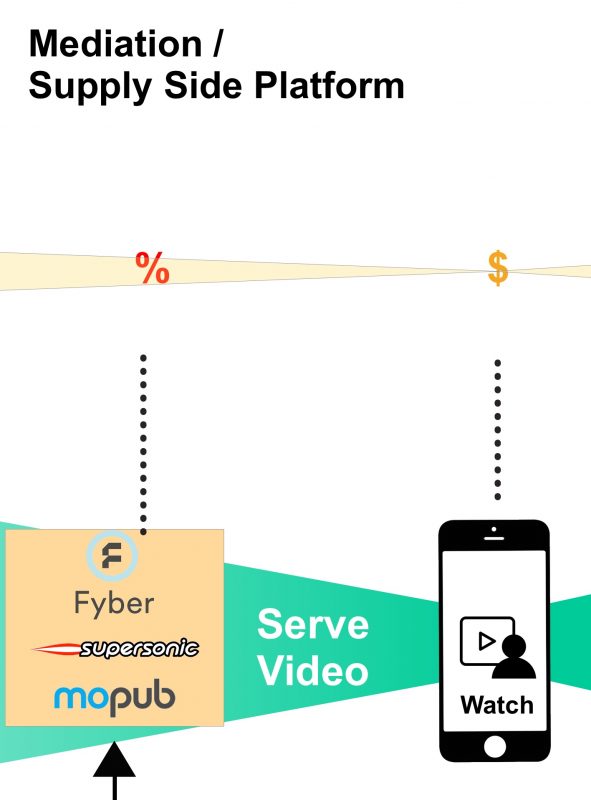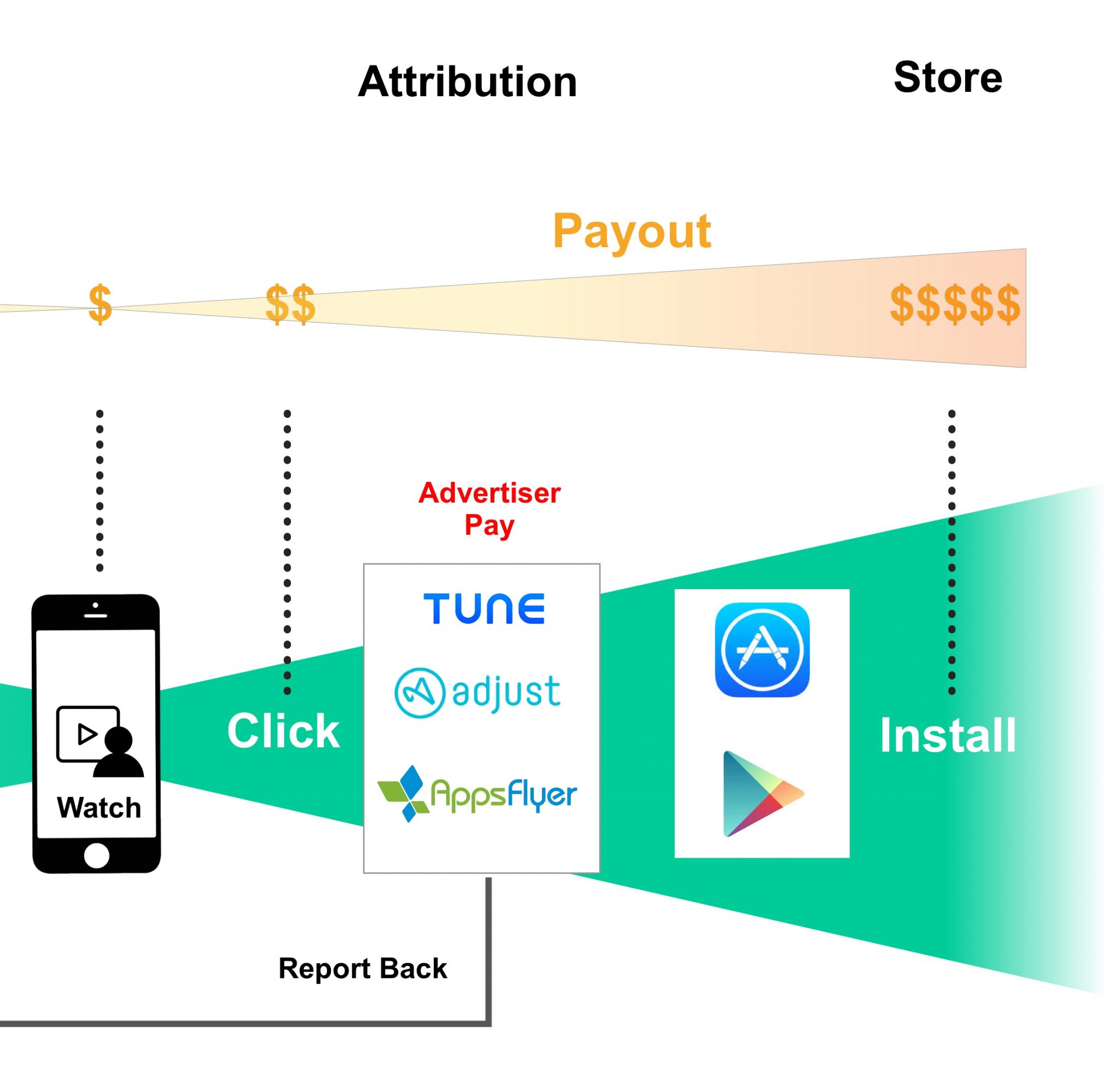Comprender la cadena de valor de los anuncios de vídeo para móviles
Los ingresos por publicidad de vídeo ahora representan una gran proporción de la mayoría de los juegos móviles gratuitos e informales. Empresas como Hipster Whale, Futureplay y el editor Ketchapp han creado modelos de negocio centrados en anuncios de vídeo recompensados. Esto muestra muchas de las similitudes del cambio de premium a freemium. Como desarrollador independiente, es relativamente sencillo incluir un anuncio de vídeo en tu juego, pero ¿entiendes de dónde viene el dinero? En este artículo desglosamos cómo llega el flujo de dinero del anunciante a su cuenta bancaria.
Descargo de responsabilidad: No tengo afiliación y no trabajo para ninguno de los socios mencionados, esta guía pretende ser una referencia para comprender dónde reside el valor y qué motiva a las empresas involucradas.

Ganar dinero con anuncios de vídeo para móviles
En pocas palabras, usted utiliza anuncios de video para ganar dinero y gana dinero porque los anunciantes pagan para mostrar videos a sus reproductores que generan instalaciones de su aplicación. Como regla general, cuantos más vídeos muestres, más dinero ganarás . Teniendo esto en cuenta, tu intención como desarrollador debería ser aumentar el número de visualizaciones de los vídeos que se muestran a tus usuarios si quieres ganar más dinero.
Sin embargo, cada vista no siempre equivale a tener dinero en efectivo en el banco. La razón de esto es que, como anunciante, desea pagar por acciones valiosas. En el mundo de los dispositivos móviles, eso significa en última instancia la instalación de una aplicación. Los desarrolladores solo ganan dinero con los jugadores que finalmente ven el anuncio completo, hacen clic y luego instalan la aplicación. Cada vista debería brindarle la mayor probabilidad de que un usuario complete el video y tenga más probabilidades de instalarlo.
Su KPI principal para maximizar los ingresos son las vistas completas por usuario activo diario .
Como no puedes controlar el comportamiento de un jugador después de haber visto un vídeo, debes centrarte en lo que puedes controlar: la visualización y el tiempo del vídeo. Dentro de sus juegos, su KPI principal para maximizar los ingresos son las vistas completas por usuario activo diario . ¡Cualquier número superior a 1 se considerará razonable y superior a 4 se considerará muy bueno! Así que fíjese el desafío de descubrir cuáles son sus vistas completadas actuales por DAU y luego intente mejorarlas.
Desmentir los mitos de los anuncios de vídeo para móviles
Como era de esperar, la mayor parte de la literatura sobre anuncios de vídeo está escrita por las propias redes publicitarias. En cada caso, tienen la misión de fomentar la aceptación de los anuncios y es probable que involucren un sesgo de selección para sacar conclusiones más positivas. Por otro lado, los desarrolladores de juegos que creen que los anuncios de vídeo rompen las experiencias, arruinan el juego y alienan a los usuarios tal vez quieran cambiar de opinión.
Mito 1: los anuncios de vídeo disminuyen la retención
Yaniv Nizan dio un interesante informe sobre los juegos de Match 3 que mostraron disminuciones en la retención de D1 de alrededor del 0,5% pero aumentos en los ingresos de más del 89% para Android o del 278% para iOS . En este caso, la pérdida insignificante en retención vale la pena en comparación con los ingresos obtenidos. En mi experiencia, no he visto grandes cambios en la retención debido a los anuncios de video, ya que fundamentalmente la retención está impulsada por la capacidad de hacer que los jugadores vuelvan al juego y los anuncios no promocionan ni disuaden a los jugadores de iniciar su aplicación. Cuando los anuncios de video se colocan en áreas donde un usuario opta por mirar y se usa un temporizador de recuperación para limitar la visualización, las recompensas y bonificaciones asociadas con el video pueden incluso atraer a los jugadores a regresar para ver más videos y obtener las recompensas.
Mito 2: los anuncios de vídeo reducen la participación
Fuse Powered (una empresa de mediación) analizó 6 millones de jugadores para mostrar que el 9% de los usuarios que vieron un anuncio de video tenían 6 veces más probabilidades de realizar una compra . Nuevamente, esta estadística puede ser engañosa, ya que es muy probable que el 9% de los usuarios que vieron un video sean los usuarios más comprometidos. Las vistas de vídeo tienden a acumularse en el extremo superior de tu base de jugadores, ya que valoran más tu moneda del juego. En lugar de que cualquier anuncio de video reduzca la participación directamente, las cohortes que miran en promedio permanecen más involucradas en los juegos en general. No cometa el error de que el anuncio en sí generó la interacción. El compromiso se crea por el deseo de gastar dinero valioso en el juego. Darles a los jugadores la oportunidad de progresar con moneda premium sin comprar un IAP es un fuerte incentivo para participar y seguir jugando.
No cometa el error de que el anuncio en sí generó la interacción.
Mito 3: Los anuncios de vídeo reducen los ingresos por compras dentro de la aplicación
Si analiza la tabla de mayores ingresos, muchos de los juegos gratuitos con mayores ingresos no mostrarán publicidad en video recompensada. Esto podría considerarse una oportunidad perdida, ya que se ha demostrado que los anuncios de vídeo mejoran el ARPDAU , pero en el caso de un juego con grandes ingresos, perder usuarios muy valiosos frente a la competencia es una mala estrategia a largo plazo.
Dicho esto, hay muchos juegos que generan mayores ingresos y tienen compras dentro de la aplicación y videos recompensados. Es una elección que usted, como desarrollador, deberá evaluar a través de sus propios datos; por lo general, puede buscar:
- If your 90 day LTV of your players is under $1 then you should be looking to increase earnings via video ads.
- If you have a very large cohort (1 million+ MAU) of players that are actively engaged then you can increase earnings via video ads.
- If your overall conversion rate from Player → Payer is below 1% then video ads will allow you to leverage the 99% of non-payers.
If the opposite of these statements is true for your game then consider reading the monetisation articles on improving ARPU in the Free to Play Bible. If you have the ability to either A/B test or remote configs then a common technique is to stop showing video ads to your payers or to only switch on video ad monetisation after a period of non-paying days.
The Mobile Video Ads Value Chain
Advertisers (demand)
 Within the industry, there are many different names for the clients on this side of the value chain: demand, publishers, brands, but I like to use “advertisers” as these are the people who pay for the adverts. Within the mobile video ad space, there are actually a relatively low number of advertisers that make up the majority of spend on the platforms. This is because running effective large campaigns can cost many $100,000+ per day. Overall the number of advertisers on mobile and their total spend continue to grow each year and show no sign of slowing.
Within the industry, there are many different names for the clients on this side of the value chain: demand, publishers, brands, but I like to use “advertisers” as these are the people who pay for the adverts. Within the mobile video ad space, there are actually a relatively low number of advertisers that make up the majority of spend on the platforms. This is because running effective large campaigns can cost many $100,000+ per day. Overall the number of advertisers on mobile and their total spend continue to grow each year and show no sign of slowing.
It’s important to understand that an advertiser will only run a campaign (a video ad on an advertising network) if they are going to generate more value than the cost of the campaign. In simple terms, they usually need to equate an ad campaign to an LTV CPI to be able to continue to run the ads.
One of the reasons rewarded video ads have become so popular is their ability to actually drive views. Every video watched is opt-in from the player who has chosen to spend the next 30 seconds to watch whatever is presented to them in order to receive a valuable reward. This works well for both gamers and advertisers as people want to watch the video at that point in time. This is why rewarded video has been one of the areas where advertisers have continued to spend big.

Nanigans
Video Ad Networks
Ad networks can get a bad rep… but they are good for one thing… they tend to throw lavish parties with lots of free drinks!

You may not like Ad guys, but they’re your best bet for driving revenue from high DAU – Low LTV games.
An ad network’s role is to talk to advertisers (i.e. Machine Zone) to run a campaign to promote apps across their network. Each campaign has different targeting (French/Dutch/German, Women, over 25) and objectives (Drive installs) and the network aims to optimise against achieving that objective. Every Ad Network has positives and negatives which can be hard to find out in advance. However, unlike the old days of print or tv advertising,a number of standard convention KPI’s that all networks provide. Comparing these numbers between networks is key to choosing which network is best for your game.
| Acronym | eCPM | CTR | Fill Rate |
| Meaning | Earnings per 1000 views shown | Click-thru-rate | Requests that receive a video. |
| Good Value (estimate) | $12-20 – T1 Country
$5-10 – T2 Country |
1-5% | 99% |
Ad networks can be private, where you receive content from a single source i.e Unity Ads or be a larger DSP (Demand Side Platforms) i.e Mobvista that aggregate lots of different ad campaigns from multiple sources.
Ad Networks tend to be very protective of their campaigns and run them exclusively on their own controlled SDKs. Demand side platforms usually allow the advertisers finer grain details of where they want to run their adverts, device, size, geo’s or even within specific apps (blacklist/whitelist). A reasonable list to check out for good ad networks from 2016 is on the Soomla site. If you’re just starting out and focussed on the US market then I would recommend Unity Ads, Applovin and AdColony as 3 networks to start with. Other smaller niche networks can work much better in other countries such as Yandex for the Russian Market. If your game starts to scale significantly, spend more time researching this field in particular.
How Do DSPs Work?
Demand Side Platforms (DSP’s) make it easier for an advertiser to buy across multiple, discrete inventory sources. The aggregate lots of different advertising channels into their single platform. DSP’s may strike a deal directly with a single large app developer for all of their views, or be working in partnership with an ad network to provide extra inventory at peak times. Due to their scale, often larger brands such as Nike or McDonlads would work with DSPs to reach the widest possible audience in the simplest way. With a single login and dashboard – running, reporting and optimising campaigns at large scales becomes much easier.
Facebook – The Biggest, Baddest Ad Network of Them All

The largest video ad network on mobile is Facebook. Unlike the other ad networks, Facebook handles all the infrastructure and tracking that is needed from the ad network to the store and even controls the display of the advertising in the apps themselves (Facebook / Instagram). This gives Facebook a huge advantage when attracting cash-rich advertisers to spend on their network as they know much more about the user and can present the user with a more relevant video. Facebook fiercely guards this data about their users and advertisers and platforms must abide by Facebook’s rules if they want to use the platform. This helps facebook maintain high-quality ads for its users.

The total mobile ad spend of 2016 is estimated to be around $40 billion and Facebook has around 1.15 billion mobile users in 2016. This huge user base is also very loyal with 66% of users logging in daily to Facebook; a metric similar to having a very high retaining game. Facebook has created its own consolidated value chain and has simplified the experience of using it from both an advertising and user perspective.
Facebook also has a lot of personal metadata about you that you willingly provide, your, age, sex and location are key pieces of data, but every like, interaction and comment can be used to guess what type of person you are. All this information allows facebook to show more relevant ads to you that you are more likely to click on and install. Inevitably this is why facebook can command higher prices for similar advertising space.
Mediation
 Mediation companies (Fyber / Supersonic) and Supply Side platforms (SSP’s) we’re setup to help developers to optimise the delivery of advertising within their app. Their role is to switch seamlessly between ad networksin order to maximise your fill rate (the number of videos shown per request made for a video) and to show the highest paying network to your audience depending on their location or other pieces of data they have collected.
Mediation companies (Fyber / Supersonic) and Supply Side platforms (SSP’s) we’re setup to help developers to optimise the delivery of advertising within their app. Their role is to switch seamlessly between ad networksin order to maximise your fill rate (the number of videos shown per request made for a video) and to show the highest paying network to your audience depending on their location or other pieces of data they have collected.
The real benefit to mediation is that as a developer you can remotely control and change your ad viewing, ad caps, network priorities and revenue reporting in one place. This benefit can save you many hours of laborious report checking and analysis to find out exactly which networks have been profitable for your game. There is no single best network or best setup: track, analyse and review on a weekly or monthly basis and adjust on what you see.
There is no single best network or best setup: track, analyse and review on a weekly or monthly basis
Mediation is usually free for developers. Although this noble endeavour of making a developer more money, most independent mediators have now been acquired or aggregated into ad networks themselves: Fyber by RNTS Media for $190 million and Supersonic by IronSource for an undisclosed fee. This allows a mediator to force a percentage of the views to their ad network of choice for which they might be reimbursed.
As a game developer adding a mediator requires a small amount of work, but it often provides you with a much more stable platform to track, analyse and review your ad networks. For that reason, I would always recommend either using a mediator or mediating SDKs yourself using a simple remote config to switch between ad network providers.
Game Developer (Supply)

You sit in the middle of the value chain. Creators of hit, fun experiences that encourage gamers to play and come back every day. Without a hit game, there would be very few people watching any of the videos.
A game developer’s primary goal is and should always be, make a fun experience that people want to come back and play again. Never lose sight of this when creating a game. Advertising slots around your experience and should not detract from it. Players are not against watching videos in order to earn valuable virtual currency. However, if there are intrusive or large un-skippable video at awkward periods within the app you are going to frustrate your user base. For videos to be effective and enjoyable you should always make them opt-in to view and allow a gamer to choose when and where to watch. This will increase engagement and video completes.
You have the audience, fundamentally that is where the value lies
You’re also the decision maker to which SDKs will be integrated. There is a lot of value to the ad companies if they can have their SDK in your game. If you have a very large audience (1 million+ DAU) then you may be able to negotiate better rates with partners. Put your business hat on and be shrewd! You have the audience, fundamentally that is where the value lies. The data of how your users play, who your users are and whether they have paid or not are all pieces of information that are highly lucrative to all parties across the value chain.
Attribution
 Attribution sits after the video has been shown to the user. These companies are responsible for tracking the install and reporting back to the Networks who was responsible for driving this user to install the game. They act as a 3rd party intermediary on the whole video ad value chain. They are also one of the only parties in the value chain that are able to charge directly for their service. Usually, they make money by charging advertisers a cost per install tracked and so add a layer of cost to any ad campaign.
Attribution sits after the video has been shown to the user. These companies are responsible for tracking the install and reporting back to the Networks who was responsible for driving this user to install the game. They act as a 3rd party intermediary on the whole video ad value chain. They are also one of the only parties in the value chain that are able to charge directly for their service. Usually, they make money by charging advertisers a cost per install tracked and so add a layer of cost to any ad campaign.
Fraud prevention is becoming more and more important as the rate of fraud is increasing with an estimation that almost 34% of all traffic is susceptible to fraud. Fraudulent traffic, such as fake installs or click-stuffing damages the whole ecosystem as it results in bad traffic. Advertisers see less value and so stop spending money on the network. Attribution attempts to pick up on these fraudulent users quickly and ban them from the ecosystem.
Third party intermediary ad networks rely on attribution to determine which ad network served the ad that led to the last click before install. This makes a big difference if you are a large publisher who is running tens if not hundreds of campaigns on multiple sources because you only want to pay once for the install. There are a large number of legal hoops that an attribution network jumps though to ensure trust for its clicks. As a smaller developer, you may not need to add in attribution if you are running a small ad campaign on a single source. Facebook and Google and many of the other video ad networks provide valid attribution for free if you advertise on their networks and you use their SDKs.
As mobile video spend grows, fraud becomes more lucrative and this part of the value chain will become more and more important for advertisers.
Stores (Apple and Google)
All installs occur via Apple and Google and so all clicks created by videos will end with a visit to their respective stores. As neither Apple nor Google gives much information about what users do on the stores it was the black box of the mobile world. Since 2015 both stores have started to give some data back to game developers in the form of store analytics, but they don’t provide this data to ad partners directly and so the post-click journey of a user is not visible and therefore hard to optimise for.
The stores add direct value to the whole chain as installs of games drive new users who may purchase in-app purchases or create brand loyalty and awareness by apps rising up the charts. The fact that there are only two major stores left in mobile, show the power they both wield and staying on the right side of both Apple and Google is a must for any mobile developer.
Conclusion – What should I do now?
With a clearer idea of the value chain in the mobile ad space, you should understand what value companies provide and who to talk to at different stages of development. Try to take some action in your current project to improve ad implementation:
Caza menor (10k MAU) : si no utiliza una empresa de mediación, busque una. Obtenga 2 o 3 redes publicitarias que conozca y en las que confíe y agregue anuncios de video a su tienda para obtener gemas gratis. Concéntrese en observar la cantidad de vistas y, a medida que el juego crezca, mejore en el seguimiento de eventos de cómo sus usuarios interactúan con el video. Utilízalo para saber cuál es el punto de referencia para las vistas de vídeo de tu juego.
Mitad del juego (100k MAU): ahora se trata de aumentar las vistas de video y aumentar los ingresos de cada vista. Trabaje con su equipo de producto para pensar en ubicaciones más innovadoras para acceder al video, dedique tiempo a adaptarlo a su tema; si puede probar ideas A/B, haga esto para aumentar las vistas completadas por DAU. Al unísono, propónganse hablar con redes publicitarias más variadas que trabajen en diferentes geografías, audiencias o tipos de juegos; podría comenzar a ganar más dinero en países no occidentales, etc. Intente incorporar entre 4 y 5 redes.
Caza grande (1 millón de MAU+): es probable que tenga una configuración razonable aquí y una persona más dedicada al marketing o la generación de ingresos. Es posible que ahora esté trabajando con entre 5 y 10 redes; evite la sobrecarga del SDK. ¿Puedes trabajar directamente con un DSP? ¿Puedes llegar a un acuerdo directo con una red publicitaria? ¿Puedes comunicarte directamente con un anunciante o una empresa de juegos?
Si los anuncios de vídeo empiezan a generar más del 50 % de sus ingresos, ¿puede crear nuevas funciones para aumentar las vistas? Recuerde comparar continuamente los ingresos de las redes y los números de seguimiento. Trabaje en una rotación quincenal para promover o degradar redes dentro de su aplicación según el rendimiento en GEO particulares.
En el futuro, escribiré más artículos sobre anuncios de video, en particular sobre cómo optimizar la ubicación en el juego y obtener vistas más completas por DAU. ¡Manténganse al tanto!
Leave a Reply